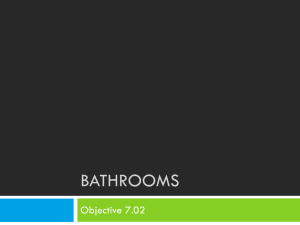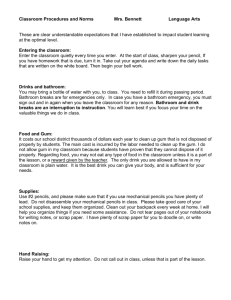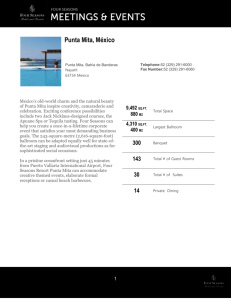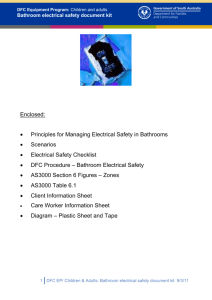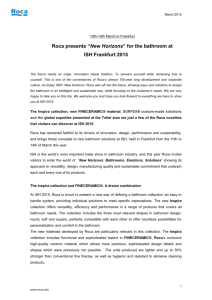The Universal Design Bathroom: Where Independence is Preserved
advertisement
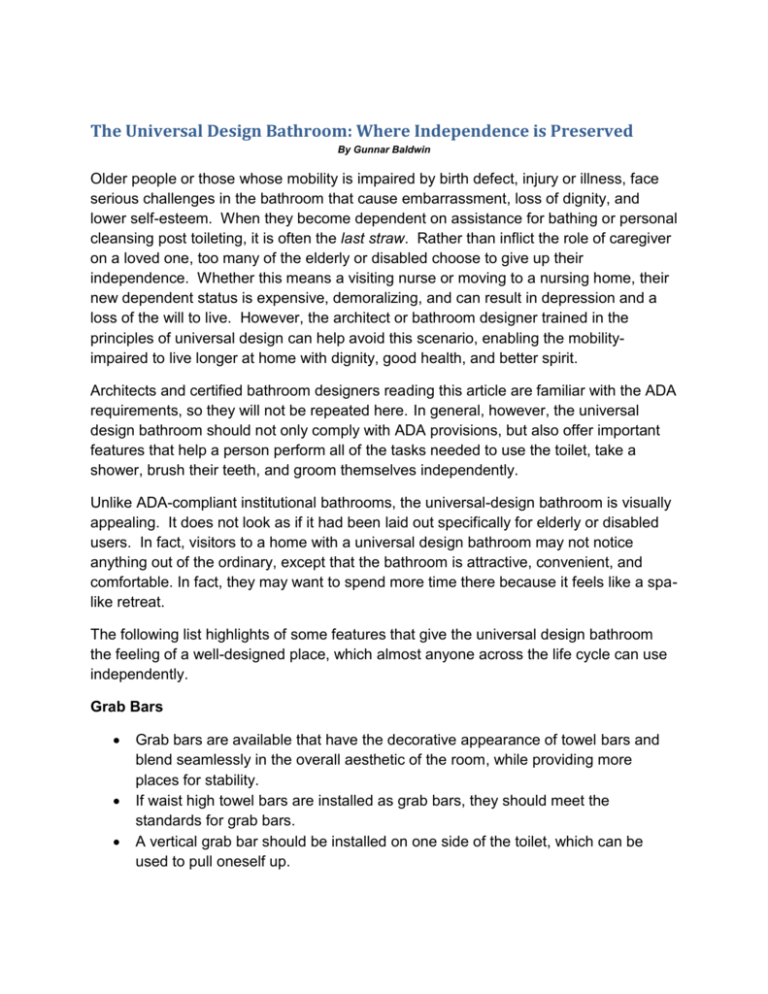
The Universal Design Bathroom: Where Independence is Preserved By Gunnar Baldwin Older people or those whose mobility is impaired by birth defect, injury or illness, face serious challenges in the bathroom that cause embarrassment, loss of dignity, and lower self-esteem. When they become dependent on assistance for bathing or personal cleansing post toileting, it is often the last straw. Rather than inflict the role of caregiver on a loved one, too many of the elderly or disabled choose to give up their independence. Whether this means a visiting nurse or moving to a nursing home, their new dependent status is expensive, demoralizing, and can result in depression and a loss of the will to live. However, the architect or bathroom designer trained in the principles of universal design can help avoid this scenario, enabling the mobilityimpaired to live longer at home with dignity, good health, and better spirit. Architects and certified bathroom designers reading this article are familiar with the ADA requirements, so they will not be repeated here. In general, however, the universal design bathroom should not only comply with ADA provisions, but also offer important features that help a person perform all of the tasks needed to use the toilet, take a shower, brush their teeth, and groom themselves independently. Unlike ADA-compliant institutional bathrooms, the universal-design bathroom is visually appealing. It does not look as if it had been laid out specifically for elderly or disabled users. In fact, visitors to a home with a universal design bathroom may not notice anything out of the ordinary, except that the bathroom is attractive, convenient, and comfortable. In fact, they may want to spend more time there because it feels like a spalike retreat. The following list highlights of some features that give the universal design bathroom the feeling of a well-designed place, which almost anyone across the life cycle can use independently. Grab Bars Grab bars are available that have the decorative appearance of towel bars and blend seamlessly in the overall aesthetic of the room, while providing more places for stability. If waist high towel bars are installed as grab bars, they should meet the standards for grab bars. A vertical grab bar should be installed on one side of the toilet, which can be used to pull oneself up. An armrest height, weight-bearing shelf may be helpful to push up on when rising from the toilet. Fold down grab bars are available, so a bar can be installed on either side of the toilet if needed. All grab bars require walls that will support them. Therefore, ¾” plywood should be used behind all of the finished walls, so, if another grab bar is needed anywhere in the bathroom, it can be installed easily. Toilets Universal height toilets should be installed, which are at least 17” high at the top of the seat. A toilet seat with bidet features, drier, deodorizer, and heated seat will make it possible for mobility-impaired individuals to cleanse themselves post toileting, without the need for assistance. The features should be operated by remote control within easy of reach the unit. These units’ warm water washing cycle and warm seat help relax the individual, which has been frequently reported to relieve constipation, a common affliction of the elderly and post-operative patients. Some of these products also have the ability to sense a person approaching and will lift the toilet’s lid, close it again, and flush the toilet after the person leaves, which can be especially useful for individuals with memory loss. A GFCI electrical outlet, preferably on a separate circuit, installed near the toilet is essential and should be standard in all bathrooms. Infection Risk Infections from bacteria or viruses brought into the bathroom are an increasing concern as people age or develop immune deficiencies. Installing floor tiles and wall coverings that reduce the ability of such pathogens to grow on their surfaces can help mitigate this risk. This information is based on third party testing per ISO standard. Test lab reports from Georgia Tech are available. Any implication of antibacterial and antiviral performance is not intended and is not reviewed or approved by EPA. Recent advances in vitreous china glazing, using nanotechnology, make the glaze used in some toilet bowls much smoother, which enables the smaller volumes of water in today’s highly water efficient toilets to thoroughly rinse the bowl with lower water consumption. Antimicrobial metals are used in these glazes. A recent innovation found in some bidet type seats moistens the bowl’s surface just before use to prevent waste from sticking to the surface, then uses electrolyzed water to mist the bowl after each use and every eight hours when not in use. The chemicals normally found in tap water are treated with electricity to give the mist properties similar to NaOCl, or common household bleach, which lasts for approximately two hours. Tubs Many modern bathrooms in North America omit a tub, which is difficult to enter, consumes a great deal of water, and still requires the addition of shower unit to the bathroom. Where tubs are installed, radiant heat panels are a good way to prevent chilling as the tub empties and individual leaves the tub, before drying off. A seat should also be installed on the tub that enables the individual’s legs to be “swung over” the wall of the tub after transferring to it. Showers Showers are often the only option for many elderly or disabled people who can no longer get in and out of the bath. The following universal design elements make showering easier for the mobility-impaired individual. A waterproof, permanent, folding or removable seat provides comfort and ease of use. It should be positioned so the shower controls can be reached easily, and the bather can turn the water on and adjust the temperature while seated and before getting wet. The shower valve should not be located directly under the showerhead. Offsetting the valve toward the entrance to the shower, or locating this control on a side wall, meets this need. Floors in the shower should have nonskid type surfaces to prevent slipping. Linear floor drains help reduce slopes and eliminate curbs which can be confusing and cause falls. A channel drain with a cover that is flush with the tile’s surface allows the entire floor surface to pitch almost imperceptibly to the back wall. This saves labor when laying the tile as well. Grab bars should be within reach from all locations within the shower enclosure. Their color should contrast with the surrounding walls, making them easy to see. Hand showers should be mounted on vertical rods, which double as grab bars. The hose should be long enough to reach anywhere within the shower enclosure. Lavatories and Faucets Lavatories that project toward a person seated in a wheelchair, a person of short stature, or a child standing in front of them make tooth brushing easier. A faucet mounted on the side of the sink is easier to reach and reduces the lavatory’s protrusion into the room. Remote control devices can be installed to make the faucet’s operation much easier. A simple push of a button mounted on the front or side of the lavatory, or the floor for foot operation, turns the faucet on and off without the need to readjust the temperature. This device also saves water because it is easier to limit the time the water is running. Today, many homeowners would rank the bathroom as second to the kitchen in importance to their lifestyle. However, older people and those with disabilities, who are trying to maintain their independence, dignity, and self-esteem, will say that the most important room in the house to their quality of life is the universal design bathroom.



